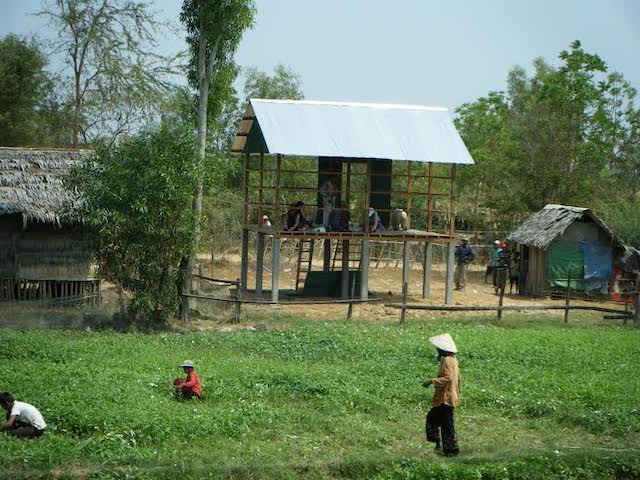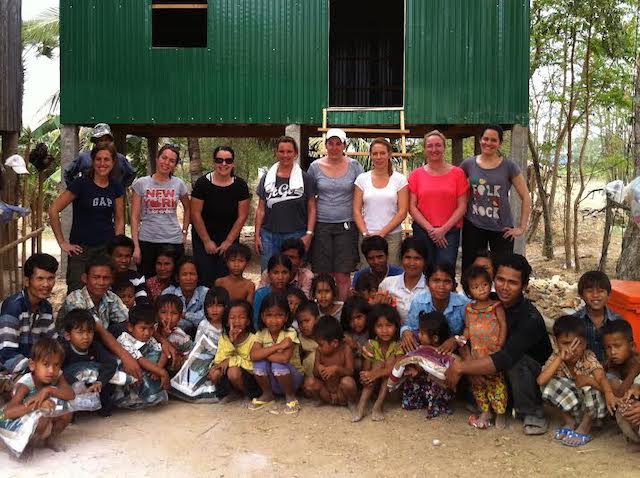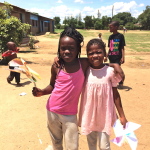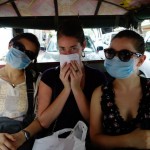Volunteer in Cambodia: Building Dream Houses

When I chose to volunteer in Cambodia for a feisty little charity there called Tabitha back in 2011, the place stole a piece of my heart and claims it still.
I was an American expat living in Tokyo with my husband and two young sons when an unexpected opportunity fell into my lap. A group of seven British mums, all “trailing spouses” like me, were going to help build houses in the Cambodian countryside for a charity, and they needed one more to complete the team. Was I up for it? I didn’t know these ladies all that well, and I knew next to nothing about Tabitha, the organization we would be working with. But I was intrigued, and besides, the team leader Katie told me she had heard I was a “ballsy New Yorker.” How could I say no? It turned out to be one of the best decisions of my life.
Tabitha Cambodia, a nonprofit organization and registered NGO based in Phnom Penh, with several supporting foundations including Tabitha USA, has been building houses for the rural poor for almost 20 years. Tabitha also runs a savings program designed to help Cambodian families invest in their own farms and small businesses and pull themselves out of poverty. Since the house-building program’s inception in 1996, 9,270 houses have been built by some 12,000 volunteers from all over the world, and 350,000 families have built their own homes with Tabitha’s support.
We were advised not to pick up or hold any babies once we got to the village; Janne said their mothers would think we wanted to keep them as compensation for the houses.
To prepare for our trip, we booked a hotel on Sisowath Quay, near the Royal Palace, and arranged to fly through Bangkok. We purchased work gloves and hammers. We hosted fundraisers in Tokyo to come up with the roughly $8,000 required to cover materials and labor for eight houses—one house per volunteer in our group. Tabitha’s own contractors would erect the wood stilt frames and roofs, and then we would go help finish the job.
The morning after we arrived in Phnom Penh, Tabitha’s founder and director Janne Ritskes welcomed us at the headquarters for orientation. We sat in a circle of folding chairs out on a covered veranda, where dozens of local women were quietly sewing silk pieces for Tabitha’s cottage industry. (The sale of silk goods is how the organization supports itself and provides local jobs.)

Volunteer in Cambodia: Building Dream Houses
Janne spoke to us about the horrors of Pol Pot’s regime, the damage wrought, and the price still being paid. She introduced us to her staff, survivors of the Khmer Rouge child labor camps, and we listened to their stories. We practiced some essential phrases in Khmer, the Cambodian language—chum riep sueh (hello), awkunh (thank you) and som toh (sorry)—while bowing our heads and holding palms in prayer, a gesture of humility and friendship. We were advised not to pick up or hold any babies once we got to the village; Janne said their mothers would think we wanted to keep them as compensation for the houses. “It’s hard for them to believe that we do not expect anything in return for our kindness,” she explained.
We had a driver take us by van out to the building site, which was in Kor, in the Sa Ang district of Kandal province, about a 90-minute drive outside the city. The village was a single dirt lane flanked by huts and shacks, with common areas for cooking and praying and hanging laundry.
There were chickens and young children chasing each other around, kicking dust up with their bare feet.
There were chickens and young children chasing each other around, kicking dust up with their bare feet. A sow the size of a bathtub lay nursing her brood of suckling pigs. Brahman cattle munched hay and swatted flies with their tails, on break from cart-pulling and other field work. Farmers in conical hats tended a nearby crop of morning glory.
It was awkward rolling into this quiet little town with our tools and sack lunch, unable to really communicate except with smiles. We were ready to work, but it was tough going. Our job was to install the flooring, by nailing bamboo slats into wooden beams, and help put up aluminum siding. We worked in two groups of four, spending a few hours on each house. Many of us fumbled with the nails and slammed our own fingers. (Bamboo really is as strong as steel.)

So why would Tabitha want a bunch of clumsy amateurs volunteering on the scene?
So why would Tabitha want a bunch of clumsy amateurs volunteering on the scene? Here’s the thing. Donor-volunteers aren’t brought in for their brawn or building expertise. You’re there to bear witness to a way of life, to see the struggles, but also the progress that is possible. It’s one thing to write a check; it’s quite another to break a sweat inside a house as it’s coming together, to meet the family who will be moving in, and to see the difference it will make to them and to the whole community. Being there makes it personal, and makes it real. It’s why so many Tabitha volunteers describe it as a life-changing experience, and return year after year.
And we managed. When we slipped up, the villagers looking on, mostly mothers and grandmothers looking after small children, would nod encouragingly. Some of the older children gathered up the nails we dropped to hand them back—they were getting used to us being there, and, no longer shy, wanted to help. The contractors were also on hand to assist, which they did cheerfully, prying up our crooked nails so we could try again. By the end of the second day, we were more relaxed and feeling connected.
It’s one thing to write a check; it’s quite another to break a sweat inside a house as it’s coming together, to meet the family who will be moving in, and to see the difference it will make to them and to the whole community.
With our eight houses finished and ready for occupancy, our team’s liaison and translator, Tari, one of Tabitha’s community development leaders, called everyone together for a formal thank you. Some of the husbands and fathers took a break from work to stand with their wives and children and to receive their house-warming gifts, silk blankets made by Tabitha’s crew, embroidered with the Tabitha name. Tari said a few words in English and in Khmer, and we posed for a group photo. Then my teammates and I climbed back into our van and waved our goodbyes. And I wondered how soon I would be able to volunteer in Cambodia again.
End note: There is no one way to become a volunteer house builder for Tabitha. You can organize your own group, and deal directly with Janne, or you can join an existing group with an experienced leader who has already organized everything. One such opportunity is coming up, with experienced team leader Margret Ellwanger, March 28 through April 4, 2015, and includes a trip to Angkor Wat and Siem Reap. Cost is $1,200 plus airfare. Email [email protected] for more information. You can also follow Tabitha USA on Facebook, or visit Tabitha USA’s site for more details about the program.










Good work, Maryanne!
Maryanne,
What’s the state of the village where you helped erect housing.Have they been able to use this as a stepping stone to better their lives or are they no better off ??
Hopefully you have followed up on this ??
Hi Mark, Tabitha works with each village in a very comprehensive way – the house building is just one part of what they do when they are working with families so they can pull themselves out of poverty. Tabitha’s approach is one of empowerment. Here is a terrific interview with Tabitha’s founder that is well worth a listen. Here is the link: http://www.davidpecklive.com/episode-28-jannes-ritskes/
Hi again Mark,
To answer your questions more directly, I have not been back to the village since volunteering there three years ago, but I can say with confidence that the recipients of the new homes are in fact better off – and not just because the Tabitha homes are larger, sturdier and safer than the homes the recipient families had been living in, but because they are part of a broader program of community development that includes other types of assistance provided over the long term. Tabitha helps struggling families build up their small businesses and gain other resources they need to better support themselves and send their children to school. After seeing Tabitha’s impact at the village level first hand, I have total faith that the organization knows what it is doing, and that it is doing good.